
Medieval
Women's Headdresses
TEMPLERS & BOSSES - HORNED HEADDRESSES -
CRESPINES & CAULS - CYLINDER CAULS
PADDED ROLLS - HEART-SHAPED HEADDRESSES
A woman's outfit was not
complete without headwear of some kind. A woman's activity and
function would have determined what kind of headwear was required.
Many of these were constructed from fabric but some were possibly
built on a wire base or used metal in their construction This
page takes a brief look at the most popular forms of medieval
headdresses.

Templers
and Bosses
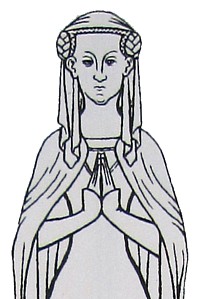 Sometimes
also known as fretts or bosses, templers were fashionable
among the upper classes during the 14th century. Chaucer, in his
prologue to the Legend of Good Women, notes Sometimes
also known as fretts or bosses, templers were fashionable
among the upper classes during the 14th century. Chaucer, in his
prologue to the Legend of Good Women, notes
'A frett of goold sche
hadde next hyre her'
indicating that these might
be made of gold or gold thread. A Dictionary of English Costume
by Cunnington and Beard, describes the headdress with the rounded
coils worn in the late 13th to end of 14th centuries as bosses.
The entry reads:
BOSSES: Decorative
cauls of net-work or linen covering the thick coils of plaited
hair, generally artificially enlarged and arranged on each side
of the head above the temples. Usually worn with a veil (coverchief).
Bosses were more commonly
known as templers. These were made of goldsmithry or fine
needlework, and were worn over the temples enclosing the hair.
They were supported by a connecting fillet crossing above the
forehead.

 The
Horned Headdress The
Horned Headdress
A Dictionary of English Costume by Cunnington & Beard
describes the horned headdress as being a that which is worn with
wide templers which are wired up to resemble horns from which
a pendant veil curtained the back of the head. It was worn from
1410 to 1420, but rarely to 1460, although, the Surtees Society's
Townley Mysteries in 1460 notes that "
'she is hornyd like
a kowe.. for syn'
indicating that at that stage
the style was persisting. The image detail at left comes from
the 15th century Guiard des Moulins Bible Historial, and
shows the horned headdress style of headdress.
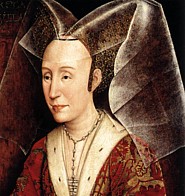 Whether
the ones worn with a thick, white, opaque veil were wired up or
not, is conjecture. Although Cunnington & Beard state they
were wired, contemporary sources do not mention wiring, to the
best of my knowledge. Whether
the ones worn with a thick, white, opaque veil were wired up or
not, is conjecture. Although Cunnington & Beard state they
were wired, contemporary sources do not mention wiring, to the
best of my knowledge.
Recreations of this style can be achieved with pinning over hair
coiled high on the head. As the styles progress to two cones,
it is again possible to recreate this with pinning.
This painting, at right,
by Rogier Van Der Weyden in the 1500s of Isabella of Portugal
is a fine example of the new richness that this style adopted
and the silken veil which was de rigeur. There appears
to be a loop at the top of the forehead centrally and it is uncertain
whether this is attached to the headdress itself to permit the
wearer to pull the piece forward in case of slippage or whether
it is a part of a cap which is worn underneath. We see this on
the hennin also.
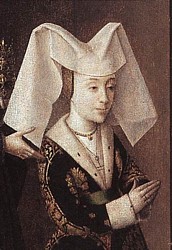 There
often appears to be some kind of support around the ear, but of
what kind, it is unclear. It is unlikely to be a securing cord
as it doesn't pass around the ear but rather stops in front of
it. Perhaps this was heavily stiffened or wired for the purpose
of securing. There
often appears to be some kind of support around the ear, but of
what kind, it is unclear. It is unlikely to be a securing cord
as it doesn't pass around the ear but rather stops in front of
it. Perhaps this was heavily stiffened or wired for the purpose
of securing.
Along with the hennin, the steeple hennin and the butterfly hennin,
the late 15th century saw the return of the horned headdress for
the upper classes.
The primary difference between this and other previous styles
of truncated headdress, is the lack of a padded roll previously
seen in earlier versions and the style of gown it was worn with.
The fabrics used were sturdier
than those of the original steeple hennin and were often geometrically
patterned brocades. The lozenge design was popular as the cloth
could be worked with precious and semiprecious gemstones and pearls
according to the pattern of the cloth.
Obviously, to show off the workmanship of such a headpiece, the
veils accompanying them were often the finest and gauziest silks
of a generous size. This allowed the wearer to appear modest with
a large veil while at the same time displaying her wealth underneath.

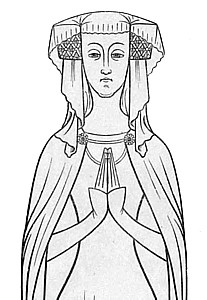 Crespines
and Cauls Crespines
and Cauls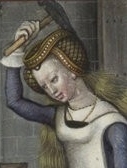
The medieval caul was often known as a fret, described by Cunnington
& Beard as a trellis-work coif or skull cap of silk thread
or goldsmithry, sometimes lined with silk. These were shaped like
modern-day hairnets, which is hardly surprising since they performed
exactly the same function.
Shown at right is a detail from a late 15th century illumination,
Mother Nature Forging Babies, showing the crespine with
a soft headband. The hair can be seen gathered at the sides of
the face through the network and the remainder of the hair hangs
loose at the back.
Clothing historian and author, Herbert Norris discusses the headdress.
usually known as the crespine or crespinette:
"known in the
middle ages as the crespine or crespinette, a network cap
to confine the hair... made during the second half of the
13th century, network caps, more properly called cauls, came
into fashion for ladies wear. These headdresses were shaped
like bags, made of gold, silver or silk network, were worn
over the hair... they enclosed the head and hair, and were
secured by a circlet or fillet.
Jewels were often set at intervals in the band, and also at
intersections of the cross-bars. The caul or crespinette was
an important headdress worn by noble ladies of this period.
The network was made of gold or silver, framed in a border
of the same metal about a half or three quarters of an inch
in width. At the intersections of the network, a single stone
or a cluster of jewels was set. Sometimes the caul was composed
entirely of a network of small pearls, and such a caul often
had at each intersection a jewel surrounded by 4, 5 or 6 pearls."
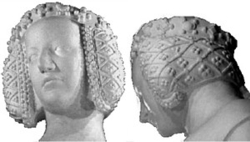 The
hair was divided into two sections at each side of the head and
restrained in cauls made from either fabric or fine metal wire.
These were usually held in place with a narrow fillet which may
or may not have an additional crown or coronet added. The
hair was divided into two sections at each side of the head and
restrained in cauls made from either fabric or fine metal wire.
These were usually held in place with a narrow fillet which may
or may not have an additional crown or coronet added.
A veil was often worn with the crespine. This fashion persisted
on and off over the next few decades. By the time of Edward III
in the 14th century, the crespine or caul was still worn, often
lined with fabric and highly decorated with pearls, goldwork and
gemstones.
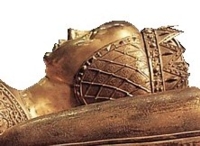 The
details shown above at left show a sculpture of Isabela Bavorska
dated between 1371 and 1435. It clearly shows a caul which has
been decorated in its entirety. It is very likely that the groupings
of 4 balls in each segment are gemstones, glass beads or pearls
which have been sewn on to a fabric coif. There is a decorated
band along the front which finishes as it curls out of sight around
the jaw line. The headpiece is worn with a jeweled coronet or
fillet over the top. The
details shown above at left show a sculpture of Isabela Bavorska
dated between 1371 and 1435. It clearly shows a caul which has
been decorated in its entirety. It is very likely that the groupings
of 4 balls in each segment are gemstones, glass beads or pearls
which have been sewn on to a fabric coif. There is a decorated
band along the front which finishes as it curls out of sight around
the jaw line. The headpiece is worn with a jeweled coronet or
fillet over the top.
Shown at right is a detail from the mausoleum of Mary of Burgundy
dated at 1502 where her jewelled crespine can be clearly seen.
She is also wearing a crown with her crespine.

Cylinder
Cauls
I'll be really honest here. I've seen a lot written about cylinder
cauls. On the whole, it's understood that Cylinder cauls were
a specific style of templer which was fashionable exclusively
among upper class women during the 14th century.
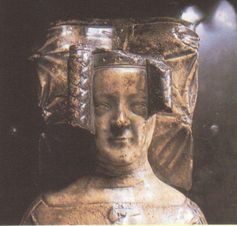 Two
cylinders were made of fine metalwork or fretwork attached to
a fillet or coronet, which could also be heavily jewelled. If
it was worn with a veil, it was worn with the finest gauzy, silk
veils which might be decorated with fine gold embroidery and narrow
edging. Two
cylinders were made of fine metalwork or fretwork attached to
a fillet or coronet, which could also be heavily jewelled. If
it was worn with a veil, it was worn with the finest gauzy, silk
veils which might be decorated with fine gold embroidery and narrow
edging.
Cylinder cauls were formal wear and for special occasions and
were not worn everyday around the house.
The only problem is, the more "cylinder cauls" I look
at, the more it really looks to me like they're just braids. Sometimes,
it looks like they're wrapped in ribbon of some kind.
In his book, Medieval Costume
and Fashion, Herbert Norris notes that while the costume for Queen
Phillipa shown on her effigy in Westminster Abbey is simple and
the headdress is very much damaged, part of the cylinders remain.
The effigy is shown at right. Looking at them, I'm still not terribly
convinced that they are anything other than braids which are dressed.

The
Padded Roll
The padded roll, or bourrelet as it was sometimes known,
was worn during the late 14th and 15th centuries, particularly
in Italy. The padded roll was nothing more than a large, padded
circlet 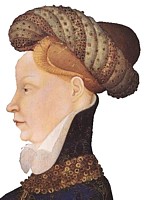 It
was often highly decorated and could be worn either alone or over
the top of another head-dress-and-veil as shown in the detail
of the three women at the top of the page. It
was often highly decorated and could be worn either alone or over
the top of another head-dress-and-veil as shown in the detail
of the three women at the top of the page.
In their book, Dress in
the Middle Ages, Francois Pipponier & Perrine Mane say
that much more voluminous headdresses built up on a padded bourrelet
came into fashion. These developed vertically and gave rise to
some amazing creations, some spherical, some cylindrical, or even
split in two like horns. They are talking of the padded roll incorporated
in other headdresses as seen on the heart-shaped headdress.
Shown at right from 1420,
Portrait of a Princess, by an unknown painter. She is wearing
an expensive houppelande and hair fashionably elongated, European-style
with the bejeweled padded roll shaped, not as a circle, but to
fit around her hair and forehead.

The
Heart-Shaped Headdress
The heart-shaped headdress combined two of the medieval woman's
favoured headdress elements to make a new style of headdress;
the earlier caul or coif, and the padded roll.
The coif was no longer made from a softer fabric or network, but
a stiffer, more rigid fabric which continued to confine the hair.
Instead of a fillet or band, it had a large padded roll affixed
to the top of the headdress As the top of the padded roll extended
heavenwards, the middle of the roll descended into a V at the
centre of the forehead making a heart shape when viewed from the
front, hence the name.
 This
style of headdress was much favoured in Europe and was worn alongside
other fabulous headwear such as the hennin and the horned headdress. This
style of headdress was much favoured in Europe and was worn alongside
other fabulous headwear such as the hennin and the horned headdress.
Shown at left is a painting of Isabella of Portugul from
Flanders dated at 1430. The richness of her headdress can be clearly
seen, with clusters of pearls and gem stones set in a geometric
pattern. She also has a securing band under her ear to support
the weight of the coif, which is also jeweled.
The padded roll of the heart-shaped
headdress could be made from coloured silks, figured or brocaded
velvets. It was often jeweled or decorated and finished off with
a small circular veil. These veils differed dramatically in that
they were often not white, sometimes daggued and usually decorated
at the edges.
The heart-shaped headdress
continued to stay in use by the middle classes during the greater
part of the 15th century, even after fashionable women had discarded
it about 1465-1470. The middle classes versions were more simplified
and less jewelled, as befitted their stations in life.
This is by no means a comprehensive guide to headdresses in the
medieval period.

Copyright
© Rosalie Gilbert
All text & photographs within this site are the property of
Rosalie Gilbert unless stated.
Art & artifact images remain the property of the owner.
Images and text may not be copied and used without permission.
|